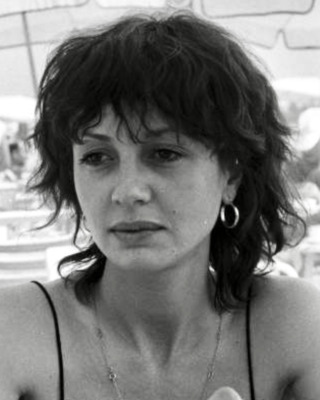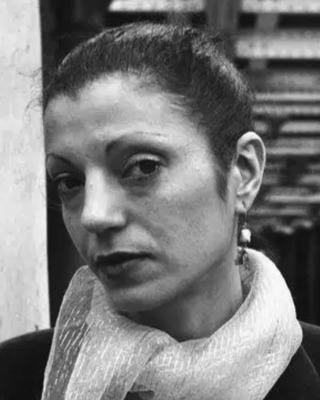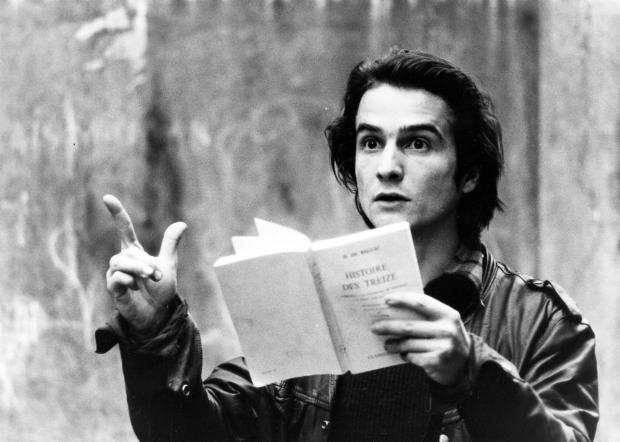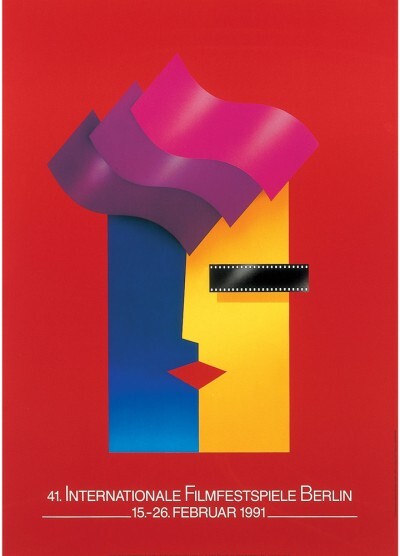Synopsis
Early episodes focus on theater groups run by Lili (Michele Moretti) and Thomas (Lonsdale), as well as Colin (Leaud) -- who pretends to be a harmonica-playing deaf-mute in cafes -- and con artist Frederique (Berto).
Lili's and Thomas' collectives are working on different Aeschylus plays. While Frederique goes through her men and spends an inordinate amount of time alone, Colin comes across papers suggesting a conspiracy involving a group of 13.
Colin's obsession leads him to such amusing encounters as one with a scholar of Balzac (played by Rivette's filmmaking contemporary Eric Rohmer), who penned a series of tomes under title "L'histoire des Treize." Picultimately abandons this conspiracy, with Leaud emotionally cleansed in one of the most exultant scenes of thesp's career.
The rise and fall of Colin's paranoia echoes the theater groups' activity and collapse, seen in extremely physical and ritualistic exercises/rehearsals consuming huge portions of the pic's running time. Passages amount to a doc on French experimental theater in the late '60s, furthering the helmer's lifelong fascination with the stage and actors.
Source : variety.com
Credits
Director (1)
Actors (46)
Production and distribution (4)
- Executive Producer : Sunchild Productions
- Co-production : Les Films du Losange
- Film exports/foreign sales : Cité Films
- French distribution : Carlotta Films
Full credits (12)
- Screenwriters : Jacques Rivette, Suzanne Schiffman
- Director of Photography : Pierre-William Glenn
- Assistant directors : Suzanne Schiffman, Jean-François Stévenin
- Editors : Nicole Lubtchansky, Carole Marquand
- Sound Recordist : René-Jean Bouyer
- Producers : Stéphane Tchalgadjieff, Danièle Gégauff, Gérard Vaugeois
- Sound Assistant : Michel Laurent
- Assistant Operator : Dominique Chapuis
- Continuity supervisor : Lydie Mahias
- Sound Mixer : Bernard Aubouy
- Still Photographer : Pierre Zucca
- Unit Production Manager : Jean-Claude Valezy
Watch this movie
Watch Out 1 in VOD
| Platforms | Model | Price | Quality |
|---|
Sorry, your search returned no results.
| Platforms | Model | Price | Quality |
|---|
Sorry, your search returned no results.
| Platforms | Model | Price | Quality |
|---|
Sorry, your search returned no results.
| Platforms | Model | Price | Quality |
|---|
Sorry, your search returned no results.
Technical details
- Type : Feature film
- Genres : Fiction
- Sub-genre : Bizarre, Research - Experimental
- Themes : Theater, Metaphysics, Intrigue
- Production language : French
- Production country : France (100.0%)
- Original French-language productions : Unspecified
- Nationality : 100% French (France)
- Production year : 1971
- French release : 18/11/2015
- Runtime : 12 h 55 min
- Current status : Released
- Approval : Unknown
- Production formats : 16mm
- Color type : Color and Black & White
- Aspect ratio : 1.66
- Audio format : Mono
TV broadcasting
This content is for registered users only.
Are you a member? Please login to view content.
News & awards
Selections (2)
About
Out 1 is a 1971 film directed by Jacques Rivette, one of the major filmmakers of the French New Wave. Notorious for its unwieldy length of twelve hours and forty minutes, it is also referred to as Out 1: Noli me tangere. When asked why the film is called Out 1, Rivette responded, "I choose "Out" as the opposite of the vogue word "in", which had caught in France and which I thought was silly. The action of the film is rather like a serial which could continue through several episodes, so I gave it the number "One"." The Spectre subtitle for the shorter version was similarly chosen for its ambiguous and various indistinct meanings, while the Noli me tangere subtitle ("don't touch me") for the original version is clearly a reference to it being the full length film as intended by Rivette.
Divided into eight episodes around 90–100 minutes each, the film is distinctly and explicitly indebted to Honoré de Balzac's La Comédie humaine, particularly the History of the Thirteen collection (1833–1835). The vast length of the film allows Rivette, like Balzac, to construct multiple loosely connected characters with independent stories whose subplots weave amongst each other and continually uncover new characters with their own subplots. This experimentation with parallel subplots was influenced by Andre Cayatte's two parts of La Vie conjugale (1963), while the use of expansive screen time was first toyed with by Rivette in L'amour fou (1969). The parallel narrative structure has since been used in many other notable films, including Kieślowski's The Decalogue and Lucas Belvaux's Trilogie, to name a few. Each of the episodes begins with a title in the form of "from person to person" (usually indicating the first and last characters seen in each episode), followed by a handful of black and white still photos recapitulating the scenes of the prior episode, then concluded by showing the final minute or so (in black and white) of the last episode before cutting into the new episode itself (which is entirely in color).
Style
Having worked with both 35 mm film and 16 mm film in L'amour fou, Rivette was comfortable enough with the 16 mm format to easily work with it on Out 1, whose massive length financially precluded any serious attempt to shoot the whole film on 35 mm. Incredibly, despite the immense length of the final product, the film was shot under a tight shooting schedule of only six weeks. Rivette's preference for the long take was the main reason why such a schedule could be maintained; as he wanted a level of realism to the performances, some of the takes include "fluffed" lines by actors, or other conventional "mistakes" such as camera and boom microphone shadows, as well as unwitting extras looking at the camera in exterior shots (including a memorable scene where two young boys doggedly follow Jean-Pierre Léaud in the middle of an extended monologue). Nonetheless, Rivette has stated that often the intimacy of performances in the face of such mistakes was precisely why he kept those takes in the film. Many of the rehearsal scenes, particularly those of the Prometheus Bound group, are composed almost entirely of long shots, although the film also contains more conventional editing pace in some other parts. The pacing of the film as a whole is also loosely based on Balzac, and the first few hours of the film are constructed more like a prologue in which the editing is slower and the characters are only introduced - it is not until three or four hours in that the ostensible motivating story lines begin to reveal themselves.
The work also includes stylistically adventurous techniques, including the shooting of extensively long shots through mirrors (again extending from work in L'amour fou), short cuts to black to punctuate otherwise continuous scenes, short cutaways to unrelated or seemingly meaningless shots, non-diegetic sounds blocking out crucial parts of dialogue, or even a conversation in which selected lines are re-edited so that they appear to be spoken backwards. However, these experiments form a fairly minimal part of the work as a whole, which is generally conventional in style (aside from the length of both takes and the whole work) and fairly easy to follow.
Exhibition
First shown as a work in progress at the Maison de la Culture in Le Havre, the film was re-edited down to a four-hour "short" version called Out 1: Spectre, which is more accessible and available (although not widely). Richard Roud, writing in The Guardian, called this version "a mind-blowing experience, but one which, instead of taking one ‘out of this world’ as the expression has it, took one right smack into the world. Or into a world which one only dimly realised was there – always right there beneath the everyday world...the cinema will never be the same again, and nor will I." Few people have seen the full-length version, though it is championed by Chicago Reader critic Jonathan Rosenbaum, who compares it to Thomas Pynchon's Gravity's Rainbow, and has included both Out 1: Noli me tangere and Out 1: Spectre in the 100 films singled out from his 1000 favourite films, published in his anthology Essential Cinema.
Out 1: Noli me tangere was restored in Germany in 1990 and was shown again at the Rotterdam and Berlin Film Festivals shortly thereafter. It disappeared again into obscurity until 2004, when both Noli me tangere and its shorter version Out 1: Spectre featured in the programme on June 1-21, in the complete retrospective Jacques Rivette Viaggio in Italia di un metteur en scène organized by Deep A.C. and curated by Goffredo De Pascale in Rome Sala Trevi Centro Sperimentale and Naples Grenoble Institut. Then, only in April/May 2006 Rivette retrospective at London's National Film Theatre, with the shorter film also screening twice across two subsequent nights at Anthology Film Archives in New York City on the same April weekend as the NFT projection of the long work. The North American premiere of Noli me tangere took place on September 23 and 24, 2006 in Vancouver's Vancouver International Film Centre organized by Vancouver International Film Festival programmer and Cinema Scope editor Mark Peranson, attended by around twenty people (22 at Peranson's initial count, before episode 1, though others came and went). A subsequent screening took place as a part of the 2006 festival over September 30 and October 1, introduced by Jonathan Rosenbaum.
The subtitled Out 1: Noli me tangere provides a particular challenge for exhibitors, as the subtitles are not burned onto the print of the film itself, as it commonplace with most foreign films shown in North America. Rather, the subtitles for Out 1, provided by the British Film Institute, are projected from a computer in a separate stream (in the Vancouver screening, just below the film itself), which then has to be synchronized with the film itself, almost certainly by someone unfamiliar with the entire Out 1. Few theatres can meet this technical challenge, especially over a thirteen hour span. In addition, the film was shot on 16mm at a nonstandard 25 frames per second, a speed few current projectors are equipped to handle. In the Vancouver screening, the film was projected at 24fps, adding about an extra half hour to the film as a whole.
Screenings of both the long and short works took place in late November and December 2006, during a large retrospective of Rivette's work which ran at the Museum of the Moving Image in Astoria, Queens, New York City. The screening of the longer version was sold out for the December 9 and 10, 2006 screening, so the Museum held an encore performance of the film on March 3 and 4 in 2007 (which came close to selling out). It was shown on both occasions over 2 days. In interviews, Rivette has explicitly stated that the work is meant to be seen theatrically "on the big screen", and apparently dislikes it being watched on a television. Ironically, the preparation of the film in eight episodes was in large part due to the "naive hope", according to Rivette, of it originally being distributed like that on French television, although his disdain for that mode of exhibition only arose after the film's completion.
Source : Wikipedia
"Out 1" is a very precise picture of post May '68 malaise - when Utopian dreams of a new society had crashed and burned, radical terrorism was starting to emerge in unlikely places and a great many other things. Two marginals who don't know one another stumble into the remnants of a "secret society": Colin, a seemingly deaf-mute who all of a sudden begins to talk and Frederique, a con artist working the "short con" (stealing drinks and tricking men who think she's a hooker out of their money). Meanwhile there are two theater groups rehearsing classic Greek dramas: "Seven Against Thebes" and "Prometheus Bound". A member of the Moretti group passes a note to Leaud about "The 13" which sends Leaud on a search for "The 13". His search brings him eventually to Bulle Ogier's shop in Les Halles "L'Angle du Hasard." Berto follows much the same path when she steals a cachet of letters from Jacques Doniol-Valcroze and tries to get money from their owners for their return. These twin activities reactivate "The 13" which had been dormant for years, revealing among other things that the two theater groups were once one.
Source : IMDb
---
Complicating the textual status of Out 1 still further is the 255-minute Out 1: Spectre (1972), which Rivette spent the better part of a year editing out of the original material — not so much a digest of the longer film as a different work with a substantially different structure and tone. Part of the fascinating difference between the two films can be seen in the ways that identical footage can often carry disparate meanings and perform radically different dramatic and narrative functions according to its separate placement in each film. (The opening shot of Spectre, for instance, occurs almost three hours into the serial. One of the more striking differences in the long version is that Michel Lonsdale, the director of one of the film’s two theater groups, emerges as the central character — not only because of his role in guiding his group’s improvisations and psychic self-explorations, but also because his ambiguous role as a rather infantile patriarch becomes pivotal to the overall movement of the plot.) The only English subtitled print of Spectre, no longer complete, has received scattered screenings in the United States since 1974, though it remains undistributed; the longer Out 1 has never been subtitled or shown here at all.
Full article on www.jonathanrosenbaum.com



































































